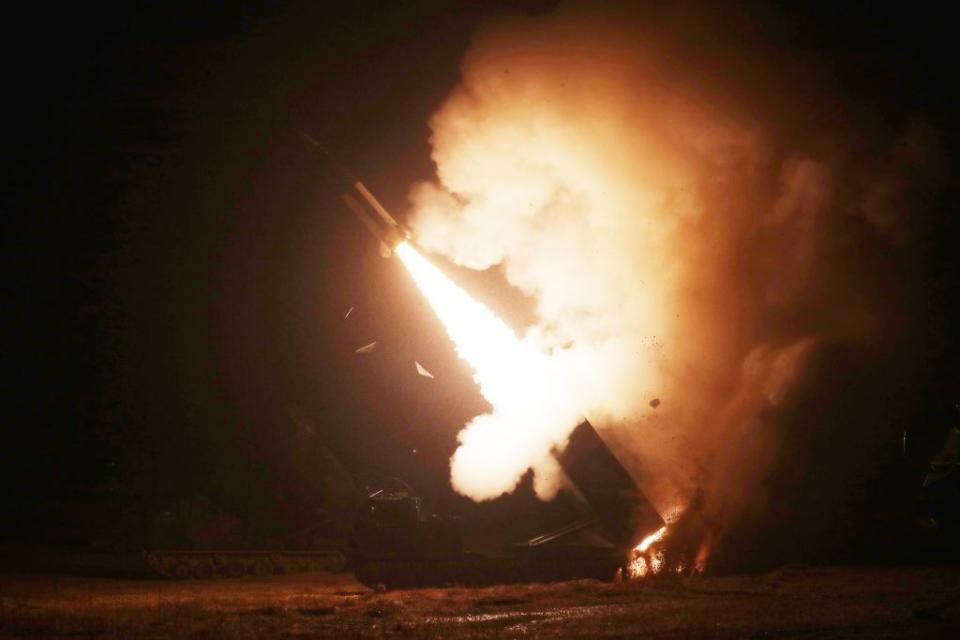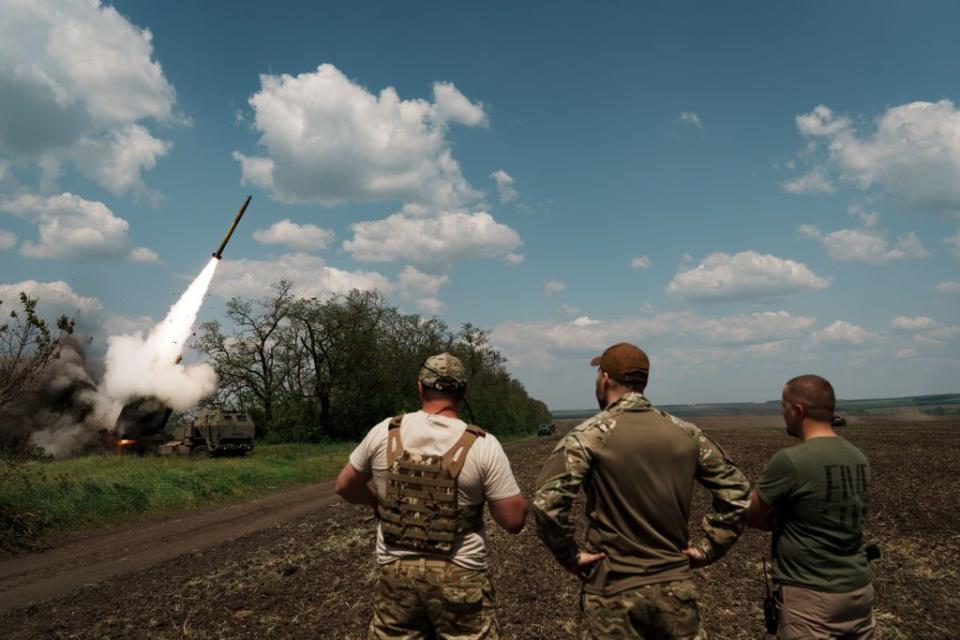US will reportedly give ATACMS to Ukraine. Will it change the war?
- Oops!Something went wrong.Please try again later.
- Oops!Something went wrong.Please try again later.
After over a year of pleading to get long-range Army Tactical Missile Systems (ATACMS) from the U.S., Ukraine might finally receive this much desired weapon.
Though to Ukraine’s disappointment it was not included in the latest military aid package worth $325 million announced by Washington on Sept. 21, NBC News reported that the decision might be underway.
According to the publication, citing unnamed U.S. officials familiar with the matter, U.S. President Joe Biden told his Ukrainian counterpart Volodymyr Zelensky that Washington would provide Ukraine with a small number of ATACMS.
The report came shortly after Zelensky’s four-day visit to the United States, during which he met with Biden and U.S. Defense Secretary Lloyd Austin.
If actually provided to Ukraine, ATACMS would allow Kyiv to consistently strike targets deep behind enemy lines, at a range of up to 300 kilometers.
But will they radically change the course of the war?
What is ATACMS?
Army Tactical Missile System, or ATACMS, is a guided surface-to-surface ballistic missile with a range of up to 300 kilometers, more than any ground-launched missiles in Ukraine's arsenal.
It was designed in the U.S. to strike targets such as command posts, air defense systems, communication centers, and logistics points. In service of the U.S. Army since 1991, ATACMS was used in the Persian Gulf and Iraq wars.
Bahrain, South Korea, Poland, Turkey, Romania, Greece, and the United Arab Emirates also have ATACMS in their stockpiles, according to its U.S. manufacturer Martin Lockheed.

ATACMS are fired from the M142 High Mobility Artillery Rocket System (HIMARS) and the M270 Multiple Launch Rocket System (MLRS), which have been efficiently used by Ukraine since last summer.
The missiles, which can reach a maximum speed of around 3,700 kilometers per hour, are difficult to intercept in the terminal phase due to their rapid descent, according to Federico Borsari, Leonardo Fellow with the Transatlantic Defense and Security Program at the Center for European Policy Analysis.
What targets could Ukraine strike with ATACMS?
ATACMS is an all-weather capability missile that can be used at any time of day to launch precise strikes on targets deep behind the front lines. It makes them especially beneficial for Ukraine's climate, unfavorable for air-launched attacks for a significant portion of the year, Viktor Kevliuk, an expert with Ukraine's Center for Defense Strategies, told the Kyiv Independent.
According to Reserve Colonel Kevliuk, the second main reason why Ukraine needs ATACMS is to use them to weaken Russia's powerful air defense capabilities. The expert explained that damaging Russian air defense systems will allow Ukraine's aviation, suffering from a shortage of attack aircraft, to fly deeper into Russian-occupied territory and strike targets there.
Read also: Increased attacks on Crimea disrupt Russian logistics, attempt to derail its southern defenses
What Ukraine could achieve with ATACMS depends on the missile variant it would get, of which there's a handful available. Each has a different level of accuracy and impact, while the oldest М39 version also has a shorter range of just 165 kilometers.
Borsari believes that Washington would likely send the Block 1A modification that can be equipped with either a submunition or a unitary warhead.
"Given these characteristics, ATACMS missile would be very useful to destroy strategically important but large, stationary objectives such as air bases (aiming to damage or destroy aircraft parked there), large military installations, radars, major troops staging areas, air-defense sites," Borsari told the Kyiv Independent.
With the 300-kilometer range, Ukraine could use ATACMS to reach nearly any target in Russian-occupied territory, including Russia's Black Sea Fleet in Sevastopol and the Crimean Bridge used by Russia to supply its troops in the south of Ukraine with equipment. Theoretically, ATACMS could also allow Ukrainian forces to strike further targets on Russian soil, but Kyiv has pledged to use ATACMS only within Ukraine’s borders.



However, as Kevliuk pointed out, hitting the 18-kilometer-long bridge, even with ATACMS, could only damage it so far to delay traffic, but the construction wouldn't collapse. He illustrated it with the example of the Antonivsky Bridge, which survived dozens of Ukrainian strikes only to fall apart when Russian forces blew up its supports.
"The Crimean Bridge needs a nuclear strike (to collapse), but this will not happen. Therefore, I do not believe this bridge will be destroyed," concluded Kevliuk.
How does ATACMS compare to other missiles in Ukraine’s arsenal?
Since May, Ukrainian forces have been using Storm Shadow/SCALP missiles jointly developed by the U.K. and France. They have a maximum range of about 250 kilometers.
However, these missiles are launched from the air, making their use dependent on weather conditions and aging Soviet-era jets in Ukraine's arsenal.
Until the U.K.'s decision to provide Storm Shadow missiles, Ukraine's maximum striking capabilities were U.S.-delivered GMLRS missiles for HIMARS launchers with a range of around 80 kilometers.
Compared with Storm Shadow/SCALP and GMLRS missiles, the ATACMS has not only a longer range but also "the ideal warhead to deliver larger area effects, instead of warheads designed to concentrate the explosion's energy on specific targets (bunkers, ships, small infrastructure like bridges)," said Borsari.


ATACMS would be Ukraine's second far-reaching land attack missile after the land-attack variant of the Ukrainian-made R-360 Neptune anti-ship missile. The Ukrainian military has reportedly used the Neptune to strike a Russian S-400 air defense system in Crimea. The modified variant of Neptune missile has a range of around 400 kilometers, an unnamed Ukrainian defense official told the War Zone, but only a couple dozen of them have been produced yet.
On Aug. 31, Zelensky said that a new Ukrainian-made long-range weapon successfully reached a target 700 kilometers away, but no details have been disclosed since then.
Aside from ATACMS, Kyiv has been campaigning to get from Germany air-launched cruise missiles Taurus that have a range of up to 500 kilometers, so far unsuccessfully.
Why has the U.S. been hesitant?
Kyiv has asked the U.S. to provide it with ATACMS for over a year, with Washington going from citing fears to provoke World War III to reassurances that ATACMS for Ukraine are still "on the table."
The White House also cited concerns over limited U.S. stockpiles of ATACMS and unnecessary escalation with Moscow in case they would be used to attack Russian territory among the reasons to reject Ukraine’s bid for the coveted missiles.

According to Borsari, other issues explaining the hesitancy could be the ATACMS cost-effectiveness per round, with a single missile costing around $850,000 compared to just $160,000 for a GMLRS rocket, as well as an evaluation of Ukraine's operational priorities.
The CEPA fellow said that the nearing U.S. Army's replacement of ATACMS with the new Precision Strike Missile (PrSM) might facilitate the arrival of ATACMS in Ukraine, which is supported by other reports.
But even if Washington changes its mind soon, it would likely take months for Ukraine to be ready to use ATACMS, according to Borsari. Existing launcher vehicles should be reconfigured and upgraded, personnel should receive specific training, and there is a logistical aspect as well, like with any other major capability.
Can ATACMS radically change course of war?
Ukrainian officials have said that ATACMS are needed to strike Russia’s critical assets parked deep behind the front lines, with Zelensky describing the missiles as vital to defeat "Russian terror."
According to Kevliuk, ATACMS would also allow Ukrainian forces to further disrupt Russian command, air defense, and logistics in the south, adding to recent successes achieved with Storm Shadows and HIMARS.
"ATACMS will also add some useful capacity as Ukrainian stocks of Storm Shadow and SCALP-EG cruise missiles dwindle, although it remains unclear exactly how many ATACMS the Pentagon would be willing to send," John Hardie, deputy director of the Russia Program at the Foundation for Defense of Democracies, told the Kyiv Independent.
Read also: Retired US General Petraeus: ‘Now it’s inevitable – we should give the ATACMS’
However, disorganizing Russian logistics and striking military equipment with ATACMS would not be enough to radically change the situation on the battlefield, according to experts. For that to happen, Ukraine would need to acquire enough armored combat vehicles, tanks, and aviation, form at least 10 new brigades, and simultaneously bring them to operation, said Kevliuk.
Borsari agreed, saying that "there are no wonder weapons in warfare, for the effective use of any weapons depends on a complex set of capabilities and factors combined."
"However, ATACMS would significantly boost Ukraine's long-range strike capabilities and put Russian second-echelon forces, logistic lines, and bases at serious risk," the expert added.
With ATACMS, Ukraine could "severely degrade enemy's fighting capabilities and, on paper, create the conditions for smoother offensive maneuver operations, as the enemy would not have the capacity to reinforce," according to Borsari.
"While not a silver bullet, ATACMS would add important capability and capacity to Ukraine's increasingly diverse arsenal of long-range precision-strike systems," Hardie said.
We’ve been working hard to bring you independent, locally-sourced news from Ukraine. Consider supporting the Kyiv Independent.

